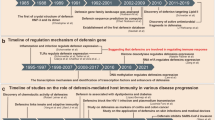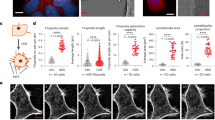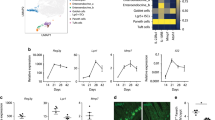Abstract
The antimicrobial peptide human α-defensin 5 (HD5) is expressed in Paneth cells, secretory epithelial cells in the small intestine. Unlike other characterized defensins, HD5 is stored in secretory vesicles as a propeptide. The storage quantities of HD5 are ∼90–450 μg per cm2 of mucosal surface area, which is sufficient to generate microbicidal concentrations in the intestinal lumen. HD5 peptides isolated from the intestinal lumen are proteolytically processed forms—HD5(56–94) and HD5(63–94)—that are cleaved at the Arg55-Ala56 and Arg62-Thr63 sites, respectively. We show here that a specific pattern of trypsin isozymes is expressed in Paneth cells, that trypsin colocalizes with HD5 and that this protease can efficiently cleave HD5 propeptide to forms identical to those isolated in vivo. By acting as a prodefensin convertase in human Paneth cells, trypsin is involved in the regulation of innate immunity in the small intestine.
This is a preview of subscription content, access via your institution
Access options
Subscribe to this journal
Receive 12 print issues and online access
$209.00 per year
only $17.42 per issue
Buy this article
- Purchase on SpringerLink
- Instant access to full article PDF
Prices may be subject to local taxes which are calculated during checkout






Similar content being viewed by others
References
Zasloff, M.A. Magainins, a class of antimicrobial peptides from Xenopus skin: Isolation, characterization of two active forms, and partial cDNA sequence of a precursor. Proc. Natl. Acad. Sci. USA 84, 5449–5453 (1987).
Ouellette, A.J. et al. Developmental regulation of cryptdin, a corticostatin/defensin precursor mRNA in mouse small intestinal crypt epithelium. J. Cell. Biol. 108, 1687–1695 (1989).
Diamond, G., Jones, D.E. & Bevins, C.L. Airway epithelial cells are the site of expression of a mammalian antimicrobial peptide gene. Proc. Natl. Acad. Sci. USA 90, 4596–4600 (1993).
Boman, H.G. Peptide antibiotics and their role in innate immunity. Annu. Rev. Immunol. 13, 61–92 (1995).
Huttner, K.M. & Bevins, C.L. Antimicrobial peptides as mediators of epithelial host defense. Pediatr. Res. 45, 785–794 (1999).
Hancock, R.E. & Diamond, G. The role of cationic antimicrobial peptides in innate host defences. Trends Microbiol. 8, 402–410 (2000).
Zasloff, M. Antimicrobial peptides of multicellular organisms. Nature 415, 389–395 (2002).
Potten, C.S. Stem cells in gastrointestinal epithelium: numbers, characteristics and death. Phil. Trans. R. Soc. Lond. B 353, 821–830 (1998).
Booth, C. & Potten, C.S. Gut instincts: thoughts on intestinal epithelial stem cells. J. Clin. Invest. 105, 1493–1499 (2000).
Simon, G.L. & Gorbach, S.L. in Infections of the Gastrointestinal Tract (eds. Blaser, M. J., Smith, P. D., Ravdin, J. I., Greenberg, H. B. & Guerrant, R. L.) 53–69 (Raven Press, New York, 1995).
Ouellette, A.J. & Selsted, M.E. Paneth cell defensins: endogenous peptide components of intestinal host defense. FASEB J. 10, 1280–1289 (1996).
Porter, E.M., Bevins, C.L., Ghosh, D. & Ganz, T. The multifaceted Paneth cell. Cell. Mol. Life Sci. 59, 156–170 (2002).
Peeters, T. & Vantrappen, G., The Paneth cell: a source of intestinal lysozyme. Gut 16, 553–558 (1975).
Harwig, S.S.L. et al. Bactericidal properties of murine intestinal phospholipase A2. J. Clin. Invest. 95, 603–610 (1995).
Nevalainen, T.J., Gronroos, J.M. & Kallajoki, M. Expression of group II phospholipase A2 in the human gastrointestinal tract. Lab. Invest. 72, 201–208 (1995).
Selsted, M.E., Miller, S.I., Henschen, A.H. & Ouellette, A.J. Enteric defensins: antibiotic peptide components of intestine host defense. J. Cell Biol. 118, 929–936 (1992).
Porter, E., Liu, L., Oren, A., Anton, P. & Ganz, T. Localization of human intestinal defensin 5 in Paneth cell granules. Infect. Immun. 65, 2389–2395 (1997).
Satoh, Y., Habara, Y., Ono, K. & Kanno, T. Carbamylcholine- and catecholamine-induced intracellular calcium dynamics of epithelial cells in mouse ileal crypts. Gastroenterology 108, 1345–1356 (1995).
Ayabe, T. et al. Modulation of mouse Paneth cell α-defensin secretion by mIKCa1, a Ca2+-activated, intermediate conductance potassium channel. J. Biol. Chem. 277, 3793–3800 (2002).
Qu, X.D., Lloyd, K.C., Walsh, J.H. & Lehrer, R.I. Secretion of type II phospholipase A2 and cryptdin by rat small intestinal Paneth cells. Infect. Immun. 64, 5161–5165 (1996).
Ayabe, T. et al. Secretion of microbicidal α-defensins by intestinal Paneth cells in response to bacteria. Nature Immunol. 1, 113–118 (2000).
Lehrer, R.I., Bevins, C.L. & Ganz, T. in Mucosal Immunology (eds. Ogra, P. L., Mestecky, J., Lamm, M. E., Strober, W. M. & Bienstock, J.) 89–99 (Academic Press, New York, 1998).
Lehrer, R.I. & Ganz, T. Defensins of vertebrate animals. Curr. Opin. Immunol. 14, 96–102 (2002).
Jones, D.E. & Bevins, C.L. Paneth cells of the human small intestine express an antimicrobial peptide gene. J. Biol. Chem. 267, 23216–23225 (1992).
Putsep, K. et al. Germ-free and colonized mice generate the same products from enteric prodefensins. J. Biol. Chem. 275, 40478–40482 (2000).
Ouellette, A.J. IV. Paneth cell antimicrobial peptides and the biology of the mucosal barrier. Am. J. Physiol. G 277, 257–261 (1999).
Bevins, C.L., Porter, E.M. & Ganz, T. Defensins and innate host defence of the gastrointestinal tract. Gut 45, 911–915 (1999).
Valore, E.V. & Ganz, T. Posttranslational processing of defensins in immature human myeloid cells. Blood 79, 1538–1544 (1992).
Harwig, S.S.L., Park, A.S.K. & Lehrer, R.I. Characterization of defensin precursors in mature human neutrophils. Blood 79, 1532–1537 (1992).
Porter, E.M. et al. Isolation of human intestinal defensins from ileal neobladder urine. FEBS Lett. 434, 272–276 (1998).
Cunliffe, R.N. et al. Human defensin 5 is stored in precursor form in normal Paneth cells and is expressed by some villous epithelial cells and by metaplastic Paneth cells in the colon in inflammatory bowel disease. Gut 48, 176–185 (2001).
Valore, E.V., Martin, E., Harwig, S.S. & Ganz, T. Intramolecular inhibition of human defensin HNP-1 by its propiece. J. Clin. Invest. 97, 1624–1629 (1996).
Wilson, C.L. et al. Regulation of intestinal α-defensin activation by the metalloproteinase matrilysin in innate host defense. Science 286, 113–117 (1999).
Porter, E., van Dam, E., Valore, E. & Ganz, T. Broad spectrum antimicrobial activity of human intestinal defensin 5. Infect. Immun. 65, 2396–2401 (1997).
Bohe, M., Borgstrom, A., Lindstrom, C. & Ohlsson, K. Pancreatic endoproteases and pancreatic secretory trypsin inhibitor immunoreactivity in human Paneth cells. J. Clin. Pathol. 39, 786–793 (1986).
Nyaruhucha, C. N., Kito, M. & Fukuoka, S. I. Identification and expression of the cDNA-encoding human mesotrypsin(ogen), an isoform of trypsin with inhibitor resistance. J. Biol. Chem. 272, 10573–10578 (1997).
Chen, J. M. & Ferec, C. Genes, cloned cDNAs, and proteins of human trypsinogens and pancreatitis-associated cationic trypsinogen mutations. Pancreas 21, 57–62 (2000).
Molmenti, E.P., Perlmutter, D.H. & Rubin, D.C. Cell-specific expression of α1-antitrypsin in human intestinal epithelium. J. Clin. Invest. 92, 2022–2034 (1993).
Bohe, H., Bohe, M., Lundberg, E., Polling, A. & Ohlsson, K. Production and secretion of pancreatic secretory trypsin inhibitor in normal human small intestine. J. Gastroenterol. 32, 623–627 (1997).
Ayabe, T. et al. Activation of Paneth cell α-defensins in mouse small intestine. J. Biol. Chem. 277, 5219–5228 (2002).
Zanetti, M., Gennaro, R., Scocchi, M. & Skerlavaj, B. Structure and biology of cathelicidins. Adv. Exp. Med. Biol. 479, 203–218 (2000).
Lehrer, R.I. & Ganz, T. Cathelicidins: a family of endogenous antimicrobial peptides. Curr. Opin. Hematol. 9, 18–22 (2002).
Zanetti, M., Litteri, L., Gennaro, R., Horstmann, H. & Romeo, D. Bactenecins, defense polypeptides of bovine neutrophils, are generated from precursor molecules stored in the large granules. J. Cell Biol. 111, 1363–1371 (1990).
Panyutich, A., Shi, J., Boutz, P.L., Zhao, C. & Ganz, T. Porcine polymorphonuclear leukocytes generate extracellular microbicidal activity by elastase-mediated activation of secreted proprotegrins. Infect. Immun. 65, 978–985 (1997).
Sorensen, O.E. et al. Human cathelicidin, hCAP-18, is processed to the antimicrobial peptide LL-37 by extracellular cleavage with proteinase 3. Blood 97, 3951–3959 (2001).
Kim, H.S. et al. Pepsin-mediated processing of the cytoplasmic histone H2A to strong antimicrobial peptide buforin I. J. Immunol. 165, 3268–3274 (2000).
Cho, J.H. et al. Cathepsin D produces antimicrobial peptide parasin I from histone H2A in the skin mucosa of fish. FASEB J. 30 (2002); advance online publication, January 30, 2002 (DOI 10.1096/fj.01-0736fje).
Jiang, H., Wang, Y. & Kanost, M.R. Pro-phenol oxidase activating proteinase from an insect, Manduca sexta: a bacteria-inducible protein similar to Drosophila easter. Proc. Natl. Acad. Sci. USA 95, 12220–12225 (1998).
Ouellette, A.J., Satchell, D.P., Hsieh, M.M., Hagen, S.J. & Selsted, M.E. Characterization of luminal Paneth cell α-defensins in mouse small intestine: attenuated antimicrobial activities of peptides with truncated amino termini. J. Biol. Chem. 275, 33969–33973 (2000).
Chertov, O. et al. Identification of defensin-1, defensin-2, and CAP37/azurocidin as T-cell chemoattractant proteins released from interleukin-8-stimulated neutrophils. J. Biol. Chem. 271, 2935–2940 (1996).
Rowen, L., Koop, B.F. & Hood, L. The complete 685-kilobase DNA sequence of the human β T cell receptor locus. Science 272, 1755–1762 (1996).
Sorsa, T. et al. Activation of type IV procollagenases by human tumor-associated trypsin-2. J. Biol. Chem. 272, 21067–21074 (1997).
Koshikawa, N. et al. Expression of trypsin by epithelial cells of various tissues, leukocytes, and neurons in human and mouse. Am. J. Pathol. 153, 937–944 (1998).
Paju, A. et al. Expression and characterization of trypsinogen produced in the human male genital tract. Am. J. Pathol. 157, 2011–2021 (2000).
Alm, A.-K., Gagnemo-Persson, R., Sorsa, T. & Sundelin, J. Extrapancreatic trypsin-2 cleaves proteinase-activated receptor-2. Biochem. Biophys. Res. Commun. 275, 77–83 (2000).
Dery, O., Corvera, C.U., Steinhoff, M. & Bunnett, N.W. Proteinase-activated receptors: novel mechanisms of signaling by serine proteases. Am. J. Physiol. C 274, 1429–1452 (1998).
Kong, W. et al. Luminal trypsin may regulate enterocytes through proteinase-activated receptor 2. Proc. Natl. Acad. Sci. USA 94, 8884–8889 (1997).
Kawabata, A. et al. The protease-activated receptor-2 agonist induces gastric mucus secretion and mucosal cytoprotection. J. Clin. Invest. 107, 1443–1450 (2001).
Danahay, H., Withey, L., Poll, C.T., van de Graaf, S. F. & Bridges, R. J. Protease-activated receptor-2-mediated inhibition of ion transport in human bronchial epithelial cells. Am. J. Physiol. Cell Physiol. C 280, 1455–1464 (2001).
Belham, C.M. et al. Trypsin stimulates proteinase-activated receptor-2-dependent and -independent activation of mitogen-activated protein kinases. Biochem. J. 320, 939–946 (1996).
Kanke, T. et al. Proteinase-activated receptor-2-mediated activation of stress-activated protein kinases and inhibitory κB kinases in NCTC 2544 keratinocytes. J. Biol. Chem. 276, 31657–31666 (2001).
Youngman, K.R. et al. Localization of intestinal interleukin-1 activity and protein and gene expression to lamina propria cells. Gastroenterology 104, 749–758 (1993).
Schagger, H. & von Jagow, G. Tricine-SDS-polyacyrlamide gel electrophoresis for the separation of proteins in the range from 1 to 100 kDa. Anal. Biochem. 166, 368–379 (1987).
Bevins, C.L. & Diamond, G. in Methods in Molecular Biology: antibacterial peptide protocols Vol. 78 (ed. Schafer,W.M.) 151–166 (Humana Press, Totowa, NJ, 1997).
Borson, N.D. A lock-docking oligo(dT) primer for 5′ and 3′ RACE PCR. PCR Meth. Appl. 2, 144–148 (1992).
Acknowledgements
We thank members of the CCF Center for Inflammatory Bowel Diseases—especially B. Lashner, J.-P. Achkar, V. Fazio and S. Strong—for obtaining tissue specimens used in this study. Some tissue samples were provided by the Cooperative Human Tissue Network, which is funded by the National Cancer Institute. We thank J. S. Lee and W. Wu for excellent assistance, and members of the Ganz and Bevins laboratories and K. Singh Aulak for helpful discussions. Supported by grants from the NIH (AI32738 to C. L. B., HL46809 to T. G. and EY06603 to J. W. C.).
Author information
Authors and Affiliations
Corresponding author
Ethics declarations
Competing interests
The authors declare no competing financial interests.
Rights and permissions
About this article
Cite this article
Ghosh, D., Porter, E., Shen, B. et al. Paneth cell trypsin is the processing enzyme for human defensin-5. Nat Immunol 3, 583–590 (2002). https://doi.org/10.1038/ni797
Received:
Accepted:
Published:
Issue Date:
DOI: https://doi.org/10.1038/ni797
This article is cited by
-
Antimicrobial Peptides as a Promising Therapeutic Strategy for Neisseria Infections
Current Microbiology (2022)
-
The alteration of gut microbiota by bioactive peptides: a review
Systems Microbiology and Biomanufacturing (2021)
-
Recombinant expression, purification and PEGylation of Paneth cell peptide (cryptdin-2) with value added attributes against Staphylococcus aureus
Scientific Reports (2020)
-
Comparative transcriptome analysis reveals the expression and characterization of digestive enzyme genes in the hepatopancreas of the Chinese mitten crab
Fisheries Science (2019)
-
Characterization of the antimicrobial peptide family defensins in the Tasmanian devil (Sarcophilus harrisii), koala (Phascolarctos cinereus), and tammar wallaby (Macropus eugenii)
Immunogenetics (2017)



